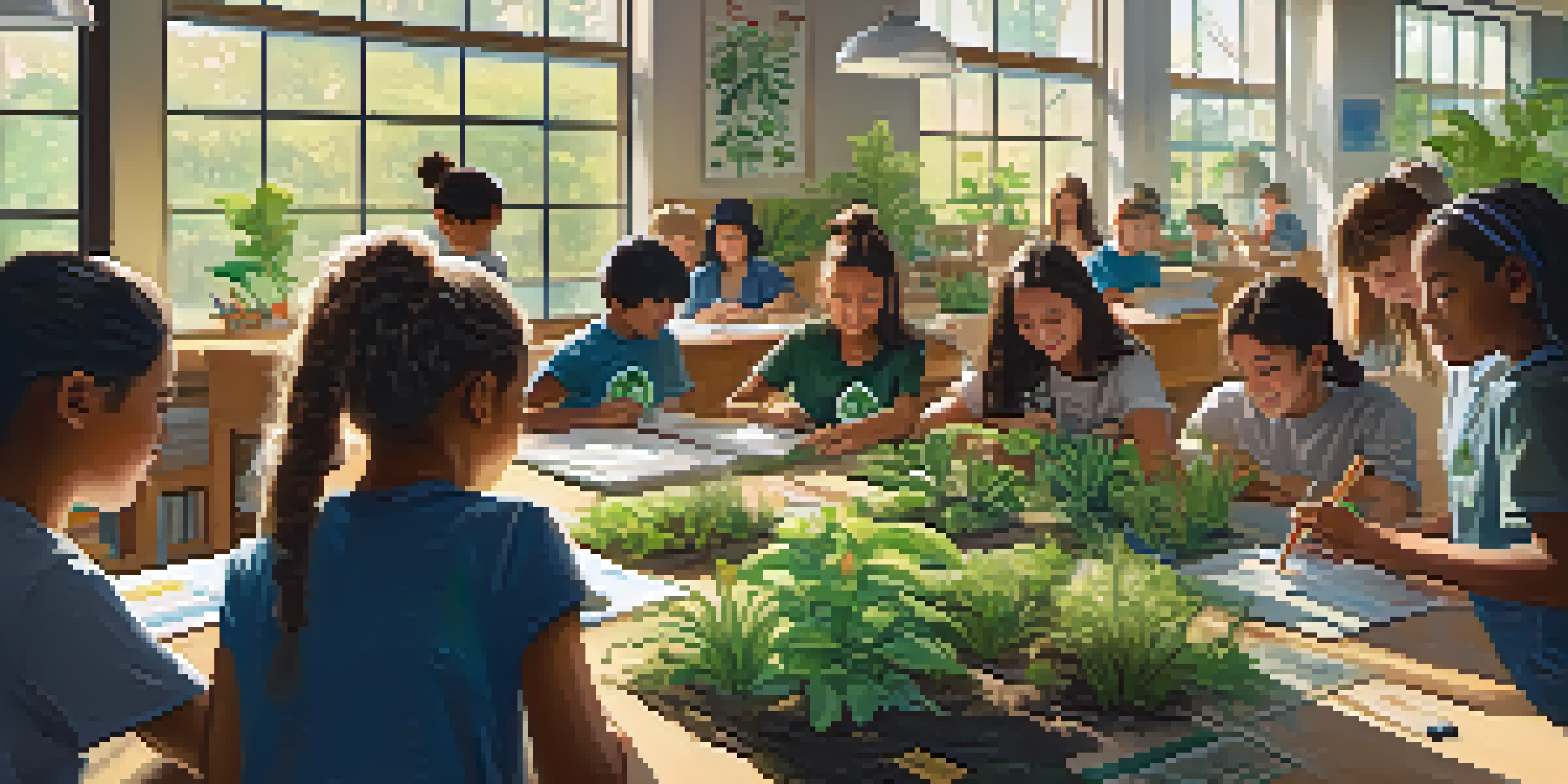Assessing the Effectiveness of Sustainability Education

Understanding Sustainability Education and Its Goals
Sustainability education aims to empower individuals with knowledge about environmental, social, and economic systems. By focusing on sustainable practices, it encourages learners to think critically about the world around them. The ultimate goal is to foster responsible citizens who can contribute to a healthier planet.
Education is the most powerful weapon which you can use to change the world.
In essence, this type of education is not just about imparting facts; it's about inspiring action and change. Whether it's in schools, universities, or community programs, sustainability education seeks to instill values of stewardship and responsibility. This foundational understanding serves as a springboard for further exploration and engagement.
As we delve into assessing its effectiveness, it’s essential to recognize the varied formats and approaches sustainability education can take. From hands-on projects to classroom lectures, each method has its unique strengths. Understanding these distinctions is crucial in measuring success.
Identifying Key Metrics for Assessment
When evaluating the effectiveness of sustainability education, identifying key metrics is paramount. These metrics can range from knowledge retention to behavioral changes among participants. By establishing clear indicators of success, educators can better gauge the impact of their programs.

For instance, pre- and post-program surveys can provide valuable insights into how learners' perceptions and behaviors have evolved. Additionally, tracking participation in sustainability initiatives can serve as a practical measure of engagement. These metrics help paint a comprehensive picture of the program's impact.
Empowering Through Sustainability Education
Sustainability education equips individuals with the knowledge and skills needed to foster responsible citizenship and promote environmental stewardship.
Beyond quantitative data, qualitative feedback from participants can shed light on personal growth and transformation. Stories from individuals about how their attitudes have shifted can be just as telling as statistics. Balancing both types of data ensures a well-rounded assessment.
The Role of Curriculum Design in Effectiveness
The design of a sustainability education curriculum plays a critical role in its effectiveness. A well-structured program that aligns with learners' interests and real-world applications can significantly enhance engagement. Incorporating project-based learning, for instance, allows students to connect theory with practice.
The greatest threat to our planet is the belief that someone else will save it.
Moreover, integrating interdisciplinary approaches can enrich the learning experience. For example, combining science, social studies, and art can lead to a deeper understanding of sustainability issues. This holistic view encourages students to think critically about the interconnections between various systems.
Ultimately, a thoughtful curriculum design not only conveys information but also fosters skills like critical thinking and problem-solving. These skills are essential for taking meaningful action in sustainability efforts. Thus, assessment should also focus on how well the curriculum prepares students for real-world challenges.
Engaging Stakeholders in the Evaluation Process
Engaging stakeholders—such as educators, students, and the community—in the evaluation process is vital for comprehensive assessment. Their input can provide diverse perspectives on the program's effectiveness. By involving these groups, the assessment becomes more inclusive and reflective of varying needs and expectations.
For instance, involving students in feedback sessions can help educators understand which aspects of the program resonate most. Similarly, discussions with community members can reveal opportunities for collaboration and real-world application of learned concepts. This engagement fosters a sense of ownership and accountability among all participants.
Assessing Effectiveness is Key
Identifying clear metrics, both quantitative and qualitative, is crucial for evaluating the impact of sustainability education programs.
Incorporating stakeholder feedback not only enhances the evaluation process but also builds stronger relationships within the community. It cultivates a collaborative spirit that can lead to ongoing improvements in sustainability education initiatives. Ultimately, this collaborative approach enriches the learning experience for everyone involved.
Utilizing Technology for Enhanced Assessment
Technology can be a powerful ally in assessing sustainability education programs. From digital surveys to interactive platforms, technology offers various tools to gather and analyze data efficiently. These tools can streamline the assessment process and provide real-time insights into program effectiveness.
For example, online learning management systems can track student engagement and participation levels, allowing educators to make data-driven decisions. Additionally, using social media for feedback can capture spontaneous reactions and discussions around sustainability topics. This immediacy can provide a richer understanding of the program's impact.
Moreover, technology can facilitate virtual collaboration and learning experiences, expanding the reach of sustainability education. By leveraging these digital tools, educators can create a more dynamic and responsive assessment framework. This adaptability is crucial in today's fast-paced educational landscape.
The Impact of Community Involvement on Effectiveness
Community involvement significantly enhances the effectiveness of sustainability education programs. When local organizations, businesses, and residents collaborate, the learning experience becomes richer and more relevant. This real-world connection helps learners see the direct impact of their education.
For example, partnerships with local environmental groups can provide students with hands-on experiences, such as tree planting or clean-up initiatives. These activities not only reinforce classroom learning but also foster a sense of community responsibility. Students are more likely to engage in sustainable practices when they see their efforts making a tangible difference.
Community Engagement Enhances Learning
Collaboration with local stakeholders enriches sustainability education, providing real-world experiences that reinforce classroom concepts.
Furthermore, community involvement can lead to increased resources and support for sustainability education initiatives. Local stakeholders can offer expertise, funding, and volunteer opportunities. This collaboration ultimately strengthens the educational program and its outcomes.
Challenges in Assessing Sustainability Education Effectiveness
Assessing the effectiveness of sustainability education isn't without its challenges. One major hurdle is the time and resources required for comprehensive evaluation. Educators may find it difficult to balance the demands of teaching with the need for thorough assessment.
Another challenge lies in the variability of programs. Each sustainability education initiative may have different goals, methods, and target audiences, making standardization tricky. This diversity means that a one-size-fits-all approach to assessment may not be effective.

Additionally, measuring long-term behavioral changes can be particularly challenging. While immediate feedback can be gathered, tracking sustained impacts over time requires ongoing commitment and follow-up. Addressing these challenges is crucial for ensuring that assessments are both meaningful and actionable.